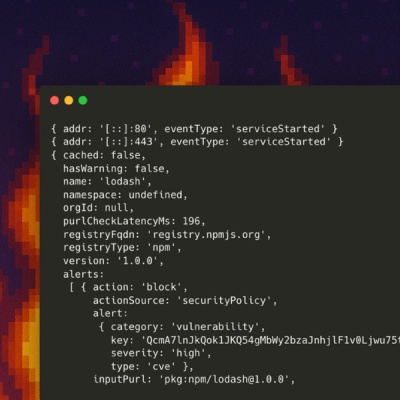
Research
/Security News
10 npm Typosquatted Packages Deploy Multi-Stage Credential Harvester
Socket researchers found 10 typosquatted npm packages that auto-run on install, show fake CAPTCHAs, fingerprint by IP, and deploy a credential stealer.
redux-optimistic-ui
Advanced tools
a reducer enhancer to enable type-agnostic optimistic updates
##Installation
npm i -S redux-optimistic-ui
A reducer enhance is a function you put around a reducer.
It can be your rootReducer (the output from a combineReducers) or a nested one.
Optimistic-UI means you update what the client sees before the result comes back from the server.
This makes your app feel super fast, regardless of server location or internet connection speed.
| redux-optimistic-ui | redux-optimist |
|---|---|
| reducerEnhancer (wraps your state in an immutable Map) | reducerExtender (adds an optimist to your state) |
| can use immutable.js or anything else | must use plain JS objects for your state |
| only uses 1 state copy | saves an extra copy of your state for every new optimistic action |
| uses immutable.js behind the scenes | uses native JS objects behind the scenes |
| FSA compliant | not FSA compliant |
must wrap your state calls in ensureState | no change necessary to get your state |
| ##Usage |
###Feed it your reducer
import {optimistic} from 'redux-optimistic-ui';
return optimistic(reducer);
This will transform your state so it looks like this:
state = Map({
history: List(),
beforeState: <YOUR PREVIOUS STATE HERE>
current: <YOUR STATE HERE>
})
If the client is not waiting for a response from the server, the following are guaranteed to be true:
state.get('history').size === 0state.get('beforeState') === undefinedIf you don't need to know if there is an outstanding fetch, you'll never need to use these.
###Update your references to state
Since your state is now wrapped, you need state.get('current').
But that sucks. What if you don't enhance the state until the user hits a certain route?
Lucky you! There's a function for that. ensureState will give you your state whether it's enhanced or not.
Just wrap all your references to state and getState with it & you're all set!
// Before
getState().counter
// After (whether you've enhanced your reducer or not)
import {ensureState} from 'redux-optimistic-ui'
ensureState(getState()).counter
###Write some middleware
Now comes the fun! Not all of your actions should be optimistic. Just the ones that fetch something from a server and have a high probability of success. I like real-world examples, so this middleware is a little bit longer than the bare requirements:
import {BEGIN, COMMIT, REVERT} from 'redux-optimistic-ui';
//All my redux action types that are optimistic have the following suffixes, yours may vary
const _SUCCESS = '_SUCCESS';
const _ERROR = '_ERROR';
//Each optimistic item will need a transaction Id to internally match the BEGIN to the COMMIT/REVERT
let nextTransactionID = 0;
// That crazy redux middleware that's 3 functions deep!
export default store => next => action => {
// FSA compliant
const {type, meta, payload} = action;
// For actions that have a high probability of failing, I don't set the flag
if (!meta || !meta.isOptimistic) return next(action);
// Now that we know we're optimistically updating the item, give it an ID
let transactionID = nextTransactionID++;
// Extend the action.meta to let it know we're beginning an optimistic update
next(Object.assign({}, action, {meta: {optimistic: {type: BEGIN, id: transactionID}}}));
// HTTP is boring, I like sending data over sockets, the 3rd arg is a callback
socket.emit(type, payload, error => {
// Create a redux action based on the result of the callback
next({
type: type + (error ? _ERROR : _SUCCESS),
error,
payload,
meta: {
//Here's the magic: if there was an error, revert the state, otherwise, commit it
optimistic: error ? {type: REVERT, id: transactionID} : {type: COMMIT, id: transactionID}
}
});
})
};
##Pro tips
Not using an optimistic-ui until a certain route? Using something like redux-undo in other parts? Write a little something like this and call it on your asychronous route:
export default (newReducers, reducerEnhancers) => {
Object.assign(currentReducers, newReducers);
const reducer = combineReducers({...currentReducers})
if (reducerEnhancers){
return Array.isArray(reducerEnhancers) ? compose(...reducerEnhancers)(reducer) : reducerEnhancers(reducer);
}
return reducer;
}
Now you get an enhanced reducer only where you want it. Neat.
To see how it all comes together, check out https://github.com/mattkrick/meatier.
FAQs
a reducer enhancer to enable type-agnostic optimistic updates
We found that redux-optimistic-ui demonstrated a not healthy version release cadence and project activity because the last version was released a year ago. It has 1 open source maintainer collaborating on the project.
Did you know?

Socket for GitHub automatically highlights issues in each pull request and monitors the health of all your open source dependencies. Discover the contents of your packages and block harmful activity before you install or update your dependencies.

Research
/Security News
Socket researchers found 10 typosquatted npm packages that auto-run on install, show fake CAPTCHAs, fingerprint by IP, and deploy a credential stealer.

Product
Socket Firewall Enterprise is now available with flexible deployment, configurable policies, and expanded language support.

Security News
Open source dashboard CNAPulse tracks CVE Numbering Authorities’ publishing activity, highlighting trends and transparency across the CVE ecosystem.